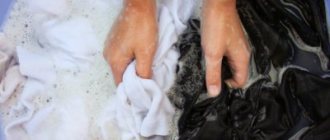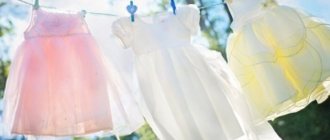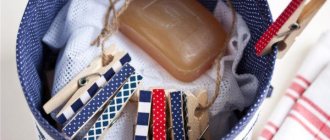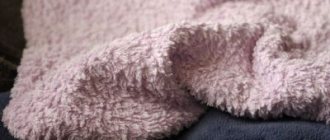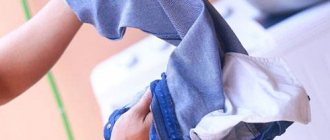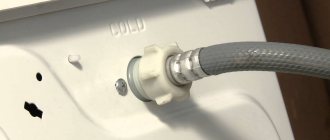An unpleasant surprise is the staining of white items after washing. Most often this happens because colored clothes were accidentally loaded into the washing machine drum.
You should not despair, as there are many ways to regain lost whiteness.
What to do if white clothes are dyed during washing, how to restore the color, how to bleach and save things? Details are in the article.
First aid
For the whitening procedure to be effective, you need to start it immediately. Waiting for the item to dry is not recommended, as this will complicate the task.
Here's what you need to do first:
Find the “culprit” of the incident. The dyed item must be removed.- Wash the faded linen again using powder.
- White linen should be washed in hot water (the maximum allowable value for a particular item).
- Use oxygen bleach to wash whites.
Under no circumstances should you iron faded fabric! This will lead to the “sealing” of the pigment in its fibers. It will be impossible to remove the paint.
How to wash so that things remain bright white?
Knowing the “physics of washing”, you can solve the problem of graying of fabric. For example, in some models of washing machines you can set a mode in which the first rinse is hot, and only the final rinse is cold.
You also need to periodically clean the washing machine drum. This is very simple to do - you need to pour two glasses of table vinegar into the drum itself, and then run the “idle” long-term wash mode. There is no need to pour vinegar into the detergent compartment.
Beautiful and Successful knows the secrets of washing with vinegar and shares with you >>
How to restore whiteness to laundry at home?
You can restore lost whiteness using folk remedies . If they are powerless, then you should use professional bleaches.
White things shed differently. Sometimes colored stains or spots appear on them, and sometimes they are completely painted in gray, pink or another shade.
In the first case, local treatment of the problem area is sufficient, and in the second, complete soaking is required.
How to whiten with folk remedies?
White items that have faded after washing can be restored using available products. Most often they are used according to a single scheme: “preparing the solution → soaking → washing as usual.”
The most effective means at hand that have a whitening effect:
Baking soda . To prepare the solution you will need 5 liters of water and 6 tbsp. l. soda Soak things in the resulting solution for 4 hours.- Laundry soap . It is grated and completely dissolved in water. The laundry is soaked in the solution for 1-2 hours.
- Vinegar. Dissolve 100 g of table vinegar in 6 liters of water. Clothes are soaked for 6 hours.
- Turpentine. For 5 liters of water you will need 5 tbsp. l. turpentine. The item is soaked in the resulting solution for 3 hours.
- Hydrogen peroxide . For 5 liters of water you will need 150 ml of liquid pharmaceutical antiseptic. The item is left in the solution for 3 hours. Peroxide is convenient to use for local stain removal. It is applied to a cotton pad and the problem area is treated.
- Ammonia. For 5 liters of water you will need 1 tbsp. l. alcohol The item is soaked for an hour.
- Starch and lemon juice . They are mixed in such a way that a thick paste is obtained. It is applied to the fabric and left to act for 12 hours.
- Potassium permanganate. Several potassium permanganate granules need to be completely dissolved in warm water. The water should be pinkish. The holding time is 2 hours.
- Lemon acid . Dissolve 2 tbsp in 5 liters of water. l. powder. Things are soaked for 2 hours.
- Aspirin. 5 tablets are dissolved in 5 liters of water. They must first be crushed into powder. Things are soaked in the solution for 8 hours.
- Mustard. Dissolve 5 tbsp in 5 liters of water. l. mustard powder. Things are soaked for 2 hours.
- Lemon juice . It is applied to the stain in its pure form. The exposure time is 2 hours. This product is used to remove local stains.
- Boric acid (alcohol solution 3%) . Dissolve 2 tbsp in 3 liters of water. l. acids. Things are soaked for 60 minutes.
- Tooth powder or white clay without additives . The selected composition is diluted with water until a thick paste is obtained. It is applied to the stain, left for 30 minutes, after which the laundry is washed as usual.
If the result of bleaching is unsatisfactory, then the item can be boiled.
Before starting the procedure, you need to make sure that the fabric can withstand exposure to high temperatures. To do this, study the information indicated on the product label.
white things correctly
take a large enamel pan, fill it with water (the container should be clean and without signs of rust);- 1 kg of laundry will require 10 liters of water;
- heat water, dissolve 250 g of liquid laundry soap and the same amount of soda in it;
- put the laundry in water and leave it to boil;
- Things need to be stirred periodically;
- Recommended cooking time is 1-1.5 hours.
After boiling, the water is drained, the laundry is cooled and rinsed in cool water.
How to save things using household chemicals?
Faded items can be washed using bleach. Scheme of their use:
- dissolve the composition in water;
- soak clothes;
- wash as usual.
Depending on the chosen composition, its dosage and exposure time will differ.
Top 3 effective remedies:
Antiline by Frau Schmidt .
This bleach and stain remover is sold in tablets. For a pack of 10 pieces you will have to pay about 230 rubles. You can buy 2 tablets for 60 rubles. To process 1 kg of laundry, 1 piece is enough. It is dissolved in 10 liters of water (temperature from 30 to 60 degrees), washing powder is not required. After an hour, the items are rinsed and normal washing begins.- Vanish Gold crystal white . To remove stains, it is better to purchase a gel. For a 0.45 liter package you will need to pay about 150 rubles. Dissolve 1 cap of detergent (60 ml) in 5 liters of water. Soaking time – up to 6 hours.
- Organic bleach Sodasan . The liquid concentrate does not contain chlorine. Its cost is 470 rubles. The product is applied to the stains and left to act for 30-60 minutes. Then wash the clothes in a machine, to which 30 ml of bleach is added.
It is not recommended to use compositions containing chlorine as bleaching agents. This substance has an aggressive effect on tissues, promoting the destruction of their fibers.
Therefore, preference is given to modern household chemicals containing active oxygen. Such compositions are effective even at low water temperatures.
The video will tell you how to save faded white clothes using BOS powder:
Clothes have faded
You followed all the rules, but your white clothes faded when washed. What to do? The main thing in such a situation is to quickly take the necessary measures. In fact, things can fade not only because of washing with colored items. It happens that a forgotten piece of paper in your pocket - a candy wrapper, a wrapper, a note - will stain your white things. In this case, you cannot do without strong bleaches.
It’s good that nowadays there is a huge selection of different brands of bleaches. But they are all divided into two types: oxygen-containing and chlorine-containing.
It is believed that chlorine has a more effective effect in terms of bleaching things, but only in the case of natural fabrics. The advantage of such bleaches is their disinfectant properties. Chlorine is excellent at killing germs and bacteria, so your items undergo additional treatment. For items made of silk and synthetics, it is advisable to use a permissible amount of chlorine-based bleach so as not to damage the fabric.
Oxygen-containing bleaches act by a chemical reaction. Oxygen crystals, when oxidized during washing, push organic substances out of the fabric of white items, while being gentle on the fibers of the fabric itself. Unlike chlorine-based products, oxygen bleaches can be used in washing machines. The effect of oxygen is much less than that of chlorine, but this product is more gentle on delicate fabrics.
Let's take a closer look at the example of two of the most famous representatives of household chemicals for whitening things.
- A representative of chlorine bleach is Whiteness.
Suitable not only for restoring faded items, but also for treating a room. The advantages are an affordable price and disinfectant properties. The downside is the strong chemical effect on the fabric. After frequent washing with white, the fibers become thinner and break.
It is forbidden to use Whiteness for silk and woolen items!
Another disadvantage of this product is that it cannot be used in a washing machine. Chlorine can damage parts and cause failure.
It should be remembered that chlorine is a chemical element that tends to evaporate. When using it, follow the rules and safety precautions to avoid burns and allergic reactions. Ventilate the room in which you wash and put on rubber gloves.
- A representative of oxygen-containing bleaches is Persol.
The advantage of this product is that it is suitable for any type of fabric due to its soft action. The oxygen contained in the composition, when exposed to contamination, does not spoil the fibers themselves. The characteristics of the bleach indicate that it can be used at any temperature. That is, it becomes possible to restore faded items even in cold water. Persalt can be used in washing machines and does not contain harsh chemicals that can cause allergies.
Under no circumstances should you experiment and mix two different bleaches to enhance the effect! This will definitely ruin your things.
Oxygen bleaches can also be used when washing children's clothes.
Now you know that white items that have not been washed correctly can be restored, but only with the use of professional products. But how to restore gray fabric?
How to return color to different types of fabric?
Depending on the type of fabric, priority bleaching methods will differ:
Cotton and linen items are not afraid of high temperatures, so they can be boiled. They are resistant to various types of bleaches, including chlorine. However, exposure time should be kept to a minimum.- Synthetic underwear is durable and wear-resistant, but does not tolerate contact with aggressive agents.
Therefore, preference should be given to gentle bleaches and folk remedies. You can use aspirin, laundry soap, lemon juice, soda, and ammonia. The maximum water temperature is 60 degrees. - Printed items should not be soaked in caustic substances. If such fabric has faded, then it must be handled carefully, trying not to get on the printed image.
- Snow-white satin should be washed in warm water (up to 40 degrees). It is not recommended to rub the fabric. The best bleaching agent is vinegar or oxygen stain remover.
- Woolen fabrics are treated only with liquid stain removers.
The more delicate the fabric, the more gentle the bleaching agents should be.
Removing gray plaque from a blouse
The first thing you can use without fear of damage to the product is modern bleaches. They are sold on the shelves of hardware stores and are divided into several classes:
- chlorine-containing;
- oxygen;
- compositions for optical purposes.
Chlorine-containing bleaches can be used on rough and thick materials. These are products like Whiteness, which contain chlorine. When using such a substance with chiffon, there is a risk of damage to the white blouse.
Another subgroup of products with whitening properties is oxygen-based. This is a well-known Vanish product, the composition of which helps to whiten a blouse at home if there is a print of a bright shade. The components carefully preserve the white color of the product without affecting the paint of the design.
Optical compositions are designed to visually lighten your favorite sweater. They will not penetrate deep into the fibers, completely cleaning the material. These products are characterized by surface cleaning, so they are suitable for silk and chiffon.
In addition to household purchased products, folk methods will help you bleach a white blouse at home if it has turned grey. They are based on the use of improvised means that are affordable.
How to prevent re-staining?
White items change their original color due to non-compliance with washing rules. To avoid this problem again after the whitening procedure, you need to adhere to several rules:
- Do not wash white and colored linen together;
- do not wash old and new items together - even if a recently purchased item has a small colored insert, it may fade;
- rinse the laundry thoroughly after washing;
- Do not dry things on heating devices or in the sun. Because of this, they may turn yellow.
If it is impossible to avoid washing white and black items together, then you need to use color-catching napkins (Chameleon, Dr. Beckmann and others). Their average cost is 300 rubles.
You can learn how to prevent shedding and save faded white things from this article.
Whiten yellowed fabric with laundry soap
Using laundry soap you can return the white color to yellowed items. This is done as follows:
- First, the soap bar is rubbed on a fine grater.
- The resulting composition is diluted in a pre-prepared container (at the rate of two tablespoons per half bucket of water).
- Substances that increase the effectiveness of bleaching (soda, for example, or potassium permanganate) are also added there.
- Then the dirty things are soaked in the prepared mixture and left for about 2-3 hours (no more).
After this time, the laundry is rinsed and washed in the usual way.
Important Tips
To prevent the bleaching process from causing even more damage to white items, you must take into account the following tips:
Follow the manufacturer's recommendations indicated on the label.- Try a new product on an inconspicuous area and monitor the tissue's reaction.
- Observe the dosage of the bleaching agent.
- Strictly follow the instructions for using the stain remover; do not leave things in it for longer than the time specified in the instructions.
- After washing, dry things properly, do not hang white and colored items on top of each other, and do not fasten them with one clothespin.
When working with aggressive compounds, you need to protect your hands with gloves and your respiratory system with a mask or respirator.
Removing yellow sweat stains
Unpleasant stains like sweat stains are difficult to remove. These stains are organic and difficult to remove, as they eat deep into the fiber structure of the fabric. Such stains can be completely removed only with aggressive chemicals, but there is a risk of damaging the fabric itself.
All that remains is to wash white items after each wear, especially in summer and winter.
If yellow spots appear in the armpit area, you can use:
- Chlorine – for linen and cotton items. Baking soda can also be used, but the effect will be less.
- Mustard powder, peroxide and ammonia - in the case of silk and wool.
- Table salt - in relation to synthetics. In order not to damage synthetic items, you will have to use only salt, of course it will take more time, but you can safely bleach this fabric.
- Soaking is a must for any fabric.
Before bleaching any item, first test your product on a small area of fabric to see the results. This way you will avoid many problems later.
Delicate whitening
We return the whiteness to underwear, the bleaching of which also has its own nuances.
When “gentle whitening” you must take into account the type of fabric from which the underwear is made, the presence of lace, and colored inserts.
If you can try to make cotton products white with laundry soap, any industrial bleach, or even use boiling, then such actions can simply ruin synthetic fabrics.
- There is an original way to restore the whiteness of a bra without resorting to bleach - use bluing.
- Wrap it in cotton cloth and immerse it in water until the liquid turns slightly bluish.
- Immerse your bra in it for 15 minutes and rinse.
Chemical bleaches
Household chemicals are an effective means of bleaching wool, capable of removing all types of contaminants. Special products can either have a whitening effect or simply be effective in fighting stains. The only thing you need to pay attention to when choosing a chemical bleach is the instructions; you need to act only according to them.
Among the popular companies of chemical bleaches are:
- Help.
- Persol.
- Vanish.
- Amway.
- Shampoo for dogs.
Important! Aggressive chemical compounds can destroy wool fibers, so you should not overexpose the product in a special product. If your white sweater has colored inserts, then the best solution is to use oxygen bleach.
When the machine is to blame
Sometimes the washing machine stains clothes with black, gray, brown stains, in some cases with oil stains, which occurs for reasons related to the unit itself. There are at least three types of problems that arise due to irregular care of household appliances; they can be easily fixed on your own.
- Dirt and mildew have accumulated in the rubber fold of the cuff.
- Mold has collected in the liquid and powder tray.
- The pump filter is not cleaned.
- The drum seal is damaged.
Cuff contamination
The passage of wastewater through the cuffs cannot occur without leaving a trace - particles of contaminants will certainly remain on this part, which over time will contribute to the formation of fungal mold. Correcting the situation is not difficult - you just need to remove the stagnant dirt and mold with a damp cloth, while bending the elastic band of the cuff. It is important to follow the rule - this part must be thoroughly wiped dry after each wash. You should also be sure to ventilate the drum of the machine, leaving the door open.
Dirty tray
Over time, dirt begins to accumulate in the tray, and fungal mold appears on it. It is quite natural that when washing white or light-colored laundry, gray or even black spots will form, but they will not disappear with normal rinsing - the items will have to be washed again. To avoid problems, the tray should be washed regularly. The best option is to rinse the part after removing it and then dry it completely.
Cleaning the filter
In any case, dirt and large debris in the form of threads, fluff and other items left in clothing pockets will collect on the filter cartridge. In the case when a regular dump pump is installed on the machine, the result of filter contamination will only be an unpleasant smell of things, from which even air conditioners will not save you. But if the pump is recirculating, then stains are added to the unpleasant odor due to the secondary passage of water. There is only one way out - regularly unscrew and rinse the filter, and you also need to remove any debris stuck in the cartridge.
The drum seal has failed
When this part wears out, the lubricant is washed out during washing, and it ends up in the laundry tank. In such a situation, things become covered with dark oil stains that resemble blots or droplets. At the same time, the bearing may rust, which will also contribute to the contamination of clothing. This problem can only be solved by replacing components. To do this you need to call a specialist.
Important : Of course, there are other reasons for the appearance of spots and stains of different colors, but the methods for eliminating the problem are more complex. In such situations, it is better to contact the service center, and they will send a qualified specialist to help you.
As you can see, stains after washing are a completely solvable problem, which in most cases you can get rid of on your own. But it’s best not to deal with the consequences, but to prevent them, saving your time and money. Such measures include timely maintenance of the automatic machine and compliance with instructions when using powders and liquids.
Did you like the article? Save it to your Pinterest! Hover over the image and click “Save.”

